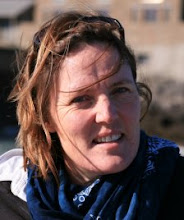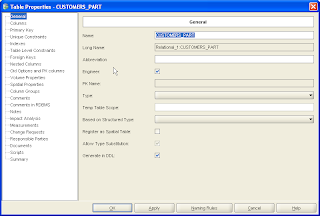Happy New Year to you all! May 2009 be a great year. I know our newspapers are full of gloom, but I'm looking forward to the year and some of the promise it holds.
2008 was quite a year for us in the
SQL Developer team. I took a month off in March to work with children in a Delhi slum and then hit the ground running on my return as we were working on bringing a new product on board and the challenges that brings. After that I was back on the road talking at as many conferences and events as we could fit in. I'm really lucky in that our development managers, Kris and Barry, will travel and talk at these events too and so I'm not so stretched and SQl Developer gets to more events. I'm hoping to get more folk involved from other teams this year and so we can settle down to working on ensuring the features you request are in the product.
Conferences I talked at in 2008 were
RMOUG, in Denver,
ODTUG, in New Orleans,
OOW, in San Francisco,
SOUG, in Glasgow, Scotland,
SAOUG, in
Pilanesberg, South Africa,
SOUG, in Switzerland, Oracle Develop, in China,
UKOUG, in Birmingham, England,
DOAG, in Nuremberg, Germany. While the list seems long, it is missing a few obvious spots! South America, Australia, New Zealand, Canada and great chunks of Europe and Asia. Perhaps if you live in an area where there is a user group and you know a bit about
SQL Developer, you should consider doing a presentation. You'd be amazed how much you learn and how little things you show folk can be really useful.
Of all the talks I do, the one on creating user defined extensions is the most fun. There are always folk in the audience who suddenly have an idea and want to go home a try them. I'm hoping to see some of those ideas come to the fore this year. Let's hear about them. I'd also love to see your laundry list of places you talked at and what you presented (On SQL Developer of course)
Of course I should mention that we started to talk about
SQL Developer Data Modeling and by the end of 2008 had released our second early adopter. We've had over 10,000 downloads of the beta software, so we're really excited that there is an interest and that many of your are testing and sending us feedback. Thank you! If you haven't tried it yet,
try now. (That link takes you to
OTN with
viewlets and
white papers and the link to the download.)
SQL Developer in 2008We had planned to go from
SQL Developer 1.2.1 to
SQL Developer 2.0, but then the list of user requests on the
SQL Developer
Exchange was so long, that we decided on an interim release and so
SQL Developer 1.5 was born. As ever we followed with a patch release to fix a few issues and so 1.5.1 was the main release of the year.
SQL Developer 1.5.2 does exist, it's the release that is part of
JDeveloper 11g, which was production soon after Oracle Open World in September. The next release planned was to address our translations and so
SQL Developer 1.5.3 was purely a translation drop, but we soon realized that not all the languages were quite accurate and as Japanese was the most requested translation release, we were able to release our Japanese build,
SQL Developer 1.5.3. So although 2008 was the year of 1.5.x, we will be slipping another 1.5.x drop into the start of 2009 with the other translations in the build.
This'll mean that
SQL Developer supports 9 languages
.
Mountains in the Snow...
I ended my year of travel in the mountains in Scotland. If you're going to walk on frozen ground, then I recommend you do that there! Actually I ended the year climbing up though a temperature inversion. Not a big deal if you're an 'plane or climbing in the Alps, but a feat in Scotland. What a day! We walked up through the mist and then the clouds onto the top of the mountain and bright skies. The white on the rock is feathery ice, not snow.
SQL Developer Events in 2009It's probably not going to be the "year of the conferences", but there are a few to add to your diaries now:
Oracle Develop: Moscow (4-5 Feb)
Oracle Develop: Prague (10 - 11 Feb)
RMOUG: Denver (10 - 12 Feb)
Collaborate: Orlando (3-7 May)
ODTUG:
Monterey (22-25 June)
OOW is in October this year in San Francisco.
That should keep us going for a while.
With the exception of Collaborate, we'll have hands on sessions at all the events. For the above events, the speakers will be Barry, Kris and I. We'll also have a few Oracle Developer Days, which
provide hands on sessions and will be run by local staff. Details for those will be on
OTN.
SQL Developer in 2009So the piece you're probably most interested in - what's up for 2009?
Well, our first release will be soon and that's the 1.5.4 release I mentioned above. We're dependent on getting all the translated files back, and then we can go,
but it
shouldn't be too many months.
Then we head for
SQL Developer 2.0. This is our "modeling" release. I use the quotes,
because we'll be releasing
SQL Developer Data Modeling as a stand alone release - a purely data modeling product, so that those of you who don't want to do any
SQL or PL/
SQL coding can just model. (and those of you who don't want to model, will not have that
included in
SQL Developer.) So the plan is to release 2 products,
SQL Developer 2.0 and
SQL Developer Data Modeling, at the same time, later this year.
If you're not a Data Modeler, don't despair,
SQL Developer 2.0 will be including a number of smaller requested features and many updates to the features that are already there.
Requesting New FeaturesBefore I close, if you're still there, I'm seeing a number of features requested that are already in the product. This means that you're not finding the nuggets of wealth ;-) in the product. If you have features you love to use or find a few things that you struggled with and then
solved, why not write it up? We have a blog we'd love you all to participate in: http://sqldevelopersig.blogspot.com/ It only has my
first entry in it, and I'd love you all to add a piece. You just need to let me know and we can give you access.
Otherwise, I'm hoping, but not committing to, writing a few more little entries here, so that you can enjoy the benefits of the features the developers have added. (According to my decline in blog entries over the last few years, I only need to do 4 this year!)
Have a good one.
Sue











